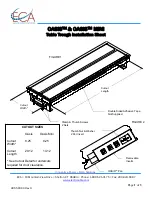
19
12.5.2. The way packed in carry cases hardness testers are located inside the
vehicle shall exclude.
12.6. Putting into operation after storage and transportation
12.6.1. After storage or transportation under the temperature lower than -5°C,
before starting hardness tester operation, it is necessary to keep it is not longer
than 1 hour under the temperature higher than +10°C and not less than 2 hours
under the temperature higher than 0°C.
12.6.2. Before operating hardness tester which was stored for more than 3 months
and transported for more than 2 months, it is necessary to check such hardness
tester on the reference hardness test blocks. If the measured AVEARGE value of
the hardness tester does not correspond to the reference hardness test block
NOMINAL value within the error limits, it is necessary to calibrate the hardness
tester.
12.7. Special operation conditions
12.7.1. Increased dust content and humidity. Put the information processing unit
of hardness tester into a transparent plastic bag. Tighten it at the level of
connective cable a bit lower than the probe plug.
After the work under such conditions is finished, information processing unit shall
taken out of the plastic bag and air it.
12.7.2. Frost (<0°C). Information processing unit is the most sensitive to low
temperature part of hardness testers, especially LCD. If there is a possibility, keep
hardness tester closer to your body and protect id with your coat or keep in the
inside pocket, taking it out time from time for inputting the data into the archive.
13. Precautions and trouble shouting
Treat the hardness tester with care. Any wrong treatment may result in the
violation of the present Technical Reference and Operation Manual regulations
and, thus, lead to the manufacturer hardness tester warranty cessation.
Always check the integrity of the cables, Information processing unit and probes.
Provide immediate replacement of the damaged parts by the original ones. This
job shall be performed by skilled personnel.
Do not expose the hardness tester to aggressive chemical medium.
Do not leave the hardness tester in the direct Sun.
Do not sink the hardness tester into any liquids. If the hardness tester gets wet,
take the battery out and leave for 24 hours to get dry. If the hardness tester is used
under the increased humidity or dust conditions, place the information processing
unit into the plastic bag. After work period is over, it is mandatory to get the
hardness tester dry.

































